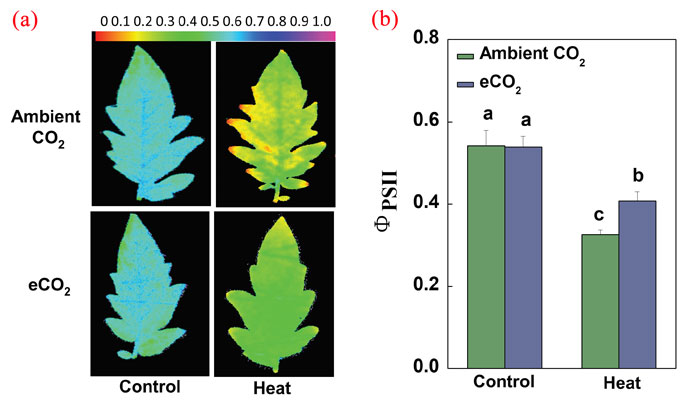| Tweet | Follow @co2science |
Paper Reviewed
Zhang, H., Pan, C., Gu, S., Ma, Q., Zhang, Y., Li, X. and Shi, K. 2019. Stomatal movements are involved in elevated CO2-mitigated high temperature stress in tomato. Physiologia Plantarum 165: 569-583.
Regardless of whether or not the climate warms in response to rising atmospheric CO2 in the future, extreme weather events will continue to play a significant role in the growth and development of plants. And so it is important to understand how plants respond to extreme events such as heatwaves under higher levels of CO2 in order to better prepare the agricultural community to deal with such threats.
The work of Zhang et al. (2019) adds to the growing database of knowledge on this subject as this team of seven Chinese researchers studied the interactive effects of elevated CO2 and a simulated heat wave on tomato (Solanum lycopersicum, cv. Ailsa Craig) seedlings. More specifically, the researchers subjected tomato plants at the five-to-six leaf stage to one of two CO2 treatments (400 or 800 ppm) in controlled-environment chambers. After two days of CO2 treatment they exposed half of the plants in each CO2 concentration to 48 hours of heat stress (+17°C above the control treatment of 25°C), hoping to discern the underlying mechanisms by which elevated CO2 often mitigates this abiotic challenge.
And what did the researchers learn?
As expected, following two days of heat shock, the ambient CO2-treated plants were severely wilted, yet plants in the elevated CO2 treatment had only just begun to wilt. Further evidence of heat stress mitigation by CO2 is presented in Figure 1, which shows -- in the authors' words -- that "elevated CO2 significantly alleviated the heat stress-related increase in relative electrical conductivity and decrease in leaf photochemical quantum yield of photosystem II (ΦPSII) values by 52% and 25%, respectively."
With respect to how this incredible feat was accomplished, further analyses revealed that elevated CO2 impacted genes associated with hydrogen peroxide (H2O2) accumulation that helped decrease stomatal aperture, which ultimately "played a crucial role in elevated CO2-induced heat tolerance by maintaining a balance between water retention and heat loss."
Such welcomed findings bode well for plants experiencing heat stress as the air's CO2 content rises in the years and decades ahead -- and not just tomato plants -- for Zhang et al. report their findings are "consistent with previous studies that describe how CO2 enrichment improves plant tolerance to various unfavorable conditions (Taub et al., 2000; Qaderi et al., 2006; Xu et al., 2013; Yu et al., 2014)."

Figure 1. (Panel A) Representative chlorophyll fluorescence images of the leaf photochemical quantum yield of photosystem II (ΦPSII) after 24 h of heat stress treatment (+17°C above control) of tomato seedlings under ambient (400 ppm) or elevated (800 ppm) CO2 (eCO2). The color gradient scale at the top of the image indicates the magnitude of the fluorescence signal. (Panel B) Leaf average ΦPSII values after 24 h of heat stress treatment under ambient or eCO2 as in Panel A. The results are presented as the means ± SD. Different letters indicate significant differences between treatments (P < 0.05) according to Tukey's test. Source: Zhang et al. (2019).
References
Qaderi, M.M., Kurepin, L.V. and Reid, D.M. 2006. Growth and physiological responses of canola (Brassica napus) to three components of global climate change: temperature, carbon dioxide and drought. Physiologia Plantarum 128: 710-721.
Taub, D.R., Seemann, J.R. and Coleman, J.S. 2000. Growth in elevated CO2 protects photosynthesis against high-temperature damage. Plant, Cell and Environment 23: 649-656.
Xu, Z., Shimizu, H., Yagasaki, Y., Ito, S., Zheng, Y. and Zhou, G. 2013. Interactive effects of elevated CO2, drought, and warming on plants. Journal of Plant Growth Regulation 32: 692-707.
Yu, J., Yang, Z., Jespersen, D. and Huang, B. 2014. Photosynthesis and protein metabolism associated with elevated CO2-mitigation of heat stress damages in tall fescue. Environmental and Experimental Botany 99: 75-85.
Posted 29 June 2020



